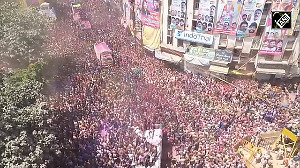While interest rates and property prices are down quite a bit, things could be better in another six months.
In the last six months, things have changed for the better for the home buyer. Most of the cities are witnessing a sharp drop in prices, almost back to where they stood in December 2006.
While most developers and brokers are unwilling to admit this, sit across the table to negotiate and you just might be surprised.
Besides property rates, interest rates have also been coming down, slowly but steadily. The recent move by all the 26 public sector banks to provide a concessional rate for housing loans up to Rs 20 lakh (Rs 2 million) should also point towards the fact that interest rates are on a southward journey.
The new rates of 8 per cent for home loans below Rs 500,000 and 9.25 per cent for loans below Rs 20 lakhs would definitely help buyers who are looking to purchase homes in tier-II and tier-III cities.
Let's look at how the ground reality has changed for home buyers in the last two years.
The fall in rates has accentuated in the last few months. In Gurgaon, the average, A-grade residential price today is Rs 5,500 a square foot (sq ft).
This is Rs 250 lower than the average price quoted two years ago, according to research data from Knight Frank Property Consultants. Just a year ago, rates were still on the rise and stood at Rs 5,638 a sq ft.
Some areas where prices had risen unreasonably have seen sharper corrections. For instance, in Greator Noida, rates are being quoted at Rs 2,650 a sq ft. This is about Rs 1,100 lower than prices in 2006 .
Even cities like Bengaluru and Pune have seen a significant drop only this year. Prices in these cities are still about 10 per cent higher than the rates two years ago. But only a few regions in the metros are still quoting higher than last year's rates.
Areas in Hyderabad and Mumbai are two such examples. However, as Pranay Vakil, chairman, Knight Frank (India), has his reservations on the quoted rates as well, "Though the quoted prices still look higher, developers are quite willing to negotiate."
The quantum of discount varies depending upon the developer and the apartment. According to a Delhi-based property consultant, a 10 per cent discount is a no-brainer, the rest depends on the negotiating skills.
As an entrepreneur recently claimed, "If you are buying a property for Rs 1 crore, payment in cash could bring down prices to even Rs 50-60 lakhs (Rs 5-6 million)."
Add to this the interest rate benefits and things have improved a lot. Though rates in prime areas may not suffer too much because of a lack of supply, there have been reports that there have been cuts in new properties in these areas as well.
For instance, rates in Lower Parel, Prabhadevi and Nepean Sea Road have seen a fall because of a lack of demand.
But the fall is more distinct in areas like Thane, where a recently-launched project by Lodha Builders at Ghodbunder Road (Thane) starts at Rs 2,997 per sq ft, which is almost 20 per cent less.
If you were to buy a two-bedroom-hall-kitchen measuring 800 sq ft, at Godhbunder Road in 2006, brokers in Thane said projects in the area were sold at Rs 30.4 lakh or Rs 3.04 million (at 3,800 per sq ft).
Considering that buyers made a self-payment of 25 per cent and took a loan for the rest at 11.25 per cent for 15 years, their equated monthly instalment would have been Rs 26,273.
Last year, the same flat would have cost Rs 32.8 lakhs (Rs 3.28 million).
If the customer were to buy a similar size flat, it could cost him around Rs 3,000-3,500 per sq ft. And if similar calculations are done, (25 per cent self-payment and 75 per cent by taking a 15-year loan from SBI at 9.25 per cent for loans below Rs 20 lakhs or Rs 2 million), the EMI today will be Rs 18,506.
Even the flat would cost around Rs 24-28 lakh (Rs 2.4 to Rs 2.8 million).
Clearly, there is a dual benefit. The EMI is down around Rs 8,000 a month and the property has also been purchased at Rs 200,000-600,000 less.
Similarly, in Greater Noida, the average property price was Rs 3,733 per sq ft in 2006. For a similar size flat and the same tenure of home loan, the EMI would have been Rs 25,810 (at 11.25 per cent).
Today, prices have crashed to Rs 2,650 a sq ft and the EMI is down to Rs 16,364.
Even in Bengaluru, the story is same. "Even in prime areas, prices have corrected a lot," said Shivram Malakala, executive director, Habitat Ventures, a real estate developer.
In areas like Koramangala that has a major concentration of offices and shopping malls, residential prices are down by 10 per cent. But the correction has come in only this year.
However, while both price corrections and fall in rates have benefited the potential buyer, experts feel that there is still some more scope for things to improve.
The reason: Builders are shifting towards affordable housing, which could lead to cheaper homes in the next few months.
"New projects will see lowering specifications, thereby reducing prices," said Akshaya Kumar, founder and CEO, Park Lane Property Advisors.
This means, there could less grandiose buildings that were offering you not just a home, but an entire lifestyle. But affordable housiong should certainly be more welcome.








 © 2025
© 2025